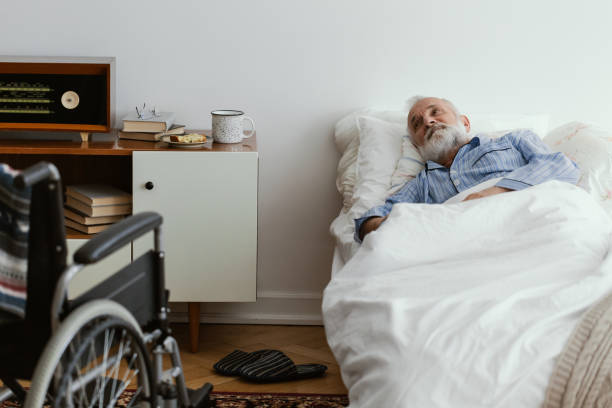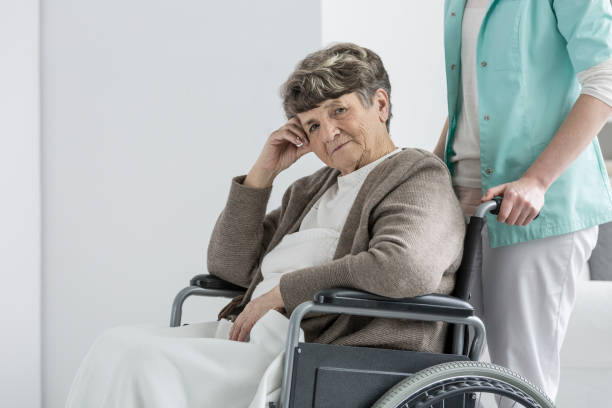Introduction

Living with Parkinson's disease can be a difficult experience. Those affected by the condition may have difficulty walking, balance problems, and impaired coordination - all of which can make simple tasks seem impossible. Additionally, patients who spend a significant amount of time in bed can face additional challenges related to their mobility.
In this blog post, we will explore the mobility challenges that Parkinson's patients in bed face and how they can be. By better understanding these issues, we can strive to improve the quality of life for those affected by this debilitating condition.
What is Parkinson's disease and its effects on mobility?
The loss of cells in the substantia nigra causes a decrease in dopamine production, leading to Parkinson's disease. This progressive neurological disorder affects deep brain stimulation and may decrease mobility.
Although symptoms can differ among individuals, some common signs of this condition include shaking, trouble with walking and balance, stiff limbs and body, changes in speaking and writing, slowed movements, and poor coordination.
The mobility challenges faced by Parkinson's patients can range from mild to severe depending on how far the disease has progressed. In general, difficulty with walking or balance is one of the most common symptoms experienced by those living with this condition. This can greatly impact the patient's ability to move freely, especially in bed.
The physical limitations of the disease and how it affects patients in bed
Individuals with Parkinson Parkinson's disease experience difficulty in controlling their movement to the progression of the neurological disorder. It is characterized by muscular rigidity, tremors, and difficulty maintaining balance and walking.
For those living with Parkinson's, physical mobility can be significantly impaired. This can have profound consequences for those who spend extended periods in bed.
Patients can experience a range of challenges regarding mobility in bed. The tremors, rigidity, and balance difficulties that characterize the disease can make movement difficult. This can further complicate turning over or adjusting positions while in bed.
Furthermore, individuals with Parkinson's often struggle to communicate their needs due to the disease's more severe symptoms, which can further impede their ability to adjust position when needed.
Understanding these mobility challenges is essential for providing adequate care for those with Parkinson's who spend time in bed. Caregivers should be aware of the potential difficulties that can arise, as well as strategies for assisting individuals with Parkinson's in bed.
For example, providing supportive pillows and other helpful tools can make it easier for the patient to turn over or adjust their position. Additionally, providing verbal instructions or cues can help individuals with Parkinson's understand what is being asked of them.
Finally, caregivers should know strategies to reduce pressure points and skin breakdown. Poor circulation can be a major issue for those with limited mobility, leading to skin problems if not managed appropriately.
Caregivers should provide support surfaces to reduce pressure points, maintain optimal circulation, and regularly reposition the patient in bed.
How to evaluate the patient's current level of mobility

Evaluating a patient's current level of mobility is an important step in managing patients with Parkinson's disease. It helps to understand their various challenges in bed and how best to address them. Multiple tools can assess mobility.
One such tool is the Mobility Assessment Scale (MAS). This observational tool evaluates the patient's ability to move from one position to another, perform daily activities such as dressing and bathing, and participate in recreational activities.
Additionally, it also measures coordination and balance. However, it does not assess physical strength or endurance.
Another useful tool for evaluating a patient's level of mobility is the Timed Up and Go (TUG). This test evaluates the patient's ability to perform basic such as standing, walking, and turning around. It is useful for detecting mobility changes over time and indicates physical functioning.
Finally, the Functional Reach Test (FRT) measures how far a patient can reach in any direction. This measure is important for evaluating the ability to transfer from one surface to another and how far they can reach during daily and recreational activities.
Strategies for helping patients with mobility issues while in bed
Offer regular re-positioning
Even if patients cannot move freely, they should be offered assistance in changing positions every two hours during the day and at least once at night. This is important for comfort and helps avoid pressure sores by distributing body weight evenly over the surface area of a mattress or bedding.
Encourage movement
While complete freedom of movement may not be possible, some level of mobility will help reduce the risk of further injury and provide psychological benefits. Patients should be encouraged to comfortably move their arms, legs, and feet to aid circulation and lessen the risk of infection or further immobility.
Use appropriate equipment
The patient should have an easily adjusted bed and other necessary medical equipment to aid mobility. This includes mobility-enhancing friction-reducing sheet and garment sets, supportive frames, bars, and straps, which can help during movement or may involve special mattresses designed to reduce pressure on joints or areas of discomfort.
Make sure the bedding is comfortable.
The patient should have an easily adjusted bed and other necessary medical equipment to aid mobility. This includes mobility-enhancing friction-reducing sheet and garment sets, supportive frames, bars, and straps, which can help during movement or may involve special mattresses designed to reduce pressure on joints or areas of discomfort.
Assist with activities
When in bed, a patient's routine may become limited, and they can easily become frustrated or bored. It is important to help with any necessary daily tasks such as bathing or dressing, which can be made much easier with the right equipment.
Additionally, offering activities such as reading material or a deck of cards for entertainment may be beneficial.
Adapting the patient's bedroom to their needs and medical requirements
In addition to providing a safe sleeping environment, and obstructive sleep apnea, adapting the bedroom of a Parkinson's patient with mobility challenges is critical to their overall well-being and care.
This may include:
-
Adjusting mattress firmness to ensure optimal comfort and support
-
Installing railings or grab bars near the bed for additional stability and balance
-
Adjusting furniture arrangements to ensure ease of movement
-
Installing raised toilet seats and non-slip mats in bathrooms
-
Utilizing low-pile carpets or rugs to reduce the risk of tripping
Creating a bedroom environment accommodating the mobility challenges unique to Parkinson's patients is essential for long-term safety, comfort, and independence. It can also assure knowing there are built-in safeguards should a fall occur.
Caregivers need to understand the mobility challenges and needs of their loved one when designing or adapting an environment that caters to these needs.
Consulting a medical professional and ensuring beds and other necessary pieces of furniture are designed with safety in mind can help ensure a comfortable and safe poor sleep-quality environment for Parkinson's patients.
Finding solutions for different types of mobility aid devices
Due to the broad range of physical therapy and cognitive challenges associated with Parkinson's disease, there is no one-size-fits-all solution for mobility aid devices. Each needs to be assessed individually to determine the most appropriate device.
Various assistive technologies are available to help improve mobility and quality of life for individuals with Parkinson's.
The most common forms of mobility aid devices are wheelchairs, walkers, and canes. Wheelchairs provide maximum support and ease of use while offering independence to move around.
Walkers help individuals who don't need full wheelchair assistance but need extra balance when walking due to their gait issues. Canes provide the least amount of support but can be used to help individuals with balance and maintain postural stability when walking.
There are also many specialized aids available for those who need more assistance getting up and out of bed or transferring from one surface to another. Specialized beds can be designed with an adjustable mattress, allowing individuals to adjust it to suit their mobility needs.
For those who need help standing and moving around, some standers can assist individuals in standing and remaining upright. Lift chairs are available that help transfer from seated to standing positions.
Why is mobility important for Parkinson's disease?

Mobility is an important factor in the quality of life of Parkinson's disease patients. Having a good range of movement helps maintain independence and autonomy, reducing risk of falls. Understanding the mobility challenges faced by Parkinson's patients while they are in bed can help caregivers provide more effective care.
One of the primary mobility challenges for Parkinson's patients in bed is the ability to shift and turn independently, which can be difficult due to the symptoms of stiffness and rigidity associated with the disease. Friction-reducing sheets and sleepwear can make all the difference.
Poor posture in bed can also lead to poor circulation, muscle strain, and additional pain or discomfort. For some Parkinson's patients, shifting and turning can be painful or even impossible.
Caregivers must know these challenges and work with the patient to provide supportive care that reduces mobility issues in bed.
Another key challenge is helping Parkinson's patients maintain a comfortable position in bed. If patients cannot shift and turn independently, their posture can become awkward and uncomfortable.
Specialized bedding equipment, such as body alignment pillows and positional wedges, can help keep the patient comfortable. It is also important to periodically check on the patient throughout the night to ensure they stay comfortable and safe.
FAQ's
Is bed mobility functional mobility?
Yes. Bed mobility is one of the most important aspects of functional mobility for Parkinson's patients. Bed mobility enables the patient to independently and safely perform tasks such as changing positions, turning over, getting in and out of bed, and reaching for objects within reach. It also helps reduce fatigue by allowing people with Parkinson's to rest and sleep-wake cycle comfortably.
What is the mobility of patients in bed?
The patient's mobility in bed is the ability to move around, shift and turn independently. This includes repositioning or turning over from one side to another, getting up and out of bed, turning onto their fronts or backs, reaching for items close by them, and adjusting pillows and blankets. Rolling from side to side, rather than turning on the same spot, is only possible in wider beds. It can be difficult if not impossible to roll from side to side on a hospital bed, or a twin/ single bed.
What is the difference between mobility and functional mobility?
Mobility is the ability to move around, while functional mobility refers to activities related to daily living, such as grooming, bathing, dressing, and eating. Mobility is an important part of functional mobility, enabling individuals with Parkinson's disease to perform everyday tasks without assistance.
How does mobility improve performance?
Good mobility and posture can help improve the performance of PD patients by reducing fatigue and pain. It also helps reduce the risk of falls and injuries and improves coordination, balance, and response time. Good mobility directly contributes to improved quality of life by enabling individuals to perform everyday tasks independently.
Conclusion
In conclusion, understanding the mobility challenges faced by Parkinson's disease patients in bed is essential for caregivers to provide effective care.
Specialized bedding equipment and supportive techniques can help improve the patient's posture, comfort, and ability to move independently.
Additionally, good mobility helps improve overall performance by reducing fatigue, pain, and the risk of injuries. With the right care, Parkinson disease patients can remain comfortable and independent in bed.

